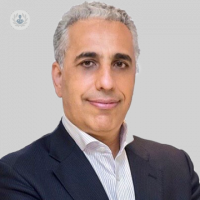Ask an expert: How are breast lumps assessed?
Written by:Following the discovery of a lump in the breast, timely investigation to establish if cancer is present is vital. In this informative guide, internationally renowned consultant oncoplastic breast surgeon Professor Kefah Mokbel offers expert insight on the different methods of testing and also gives reassurance on what patients undergoing assessment of breast lumps should expect.

How are breast lumps assessed?
Breast lumps are comprehensively investigated by triple assessment: physical examination, breast imaging and needle biopsy.
1. Physical examination
The doctor at the breast clinic carries out a physical examination of both breasts and armpits after asking certain questions about the history of the symptoms and family history. The doctor will confirm if there is a lump and record the size and index of suspicion on a scale from P1 to P5.
P stands for physical examination:
- P1 refers to normal findings
- P2 refers to benign (non-cancerous) ‘innocent’ findings
- P3 refers to indeterminate but most likely benign findings
- P4 refers to findings suspicious for cancer
- P5 refers to the presence of cancer
2. Breast imaging
a. Ultrasound scan
Ultrasound examination is recommended for all women with breast lumps. Using sound waves transmitted through a probe, an ultrasound scan provides images of the internal body. It is performed by a radiologist and as ultrasound scanning does not use radiation, this type of imaging scan is completely harmless and causes very little discomfort if any at all. During the scan, the sound waves are reflected through the body and back to the machine, meaning they can be transformed into an image which can be viewed on a monitor.
When assessing breast lumps, a probe is placed over the breast and a lubricating gel is administered to the skin to facilitate the process. Using the ultrasound scan images, the specialist can determine if a breast lump is a cyst (a liquid filled sac) or a solid lump. This type of test is very effective in distinguishing between cysts and solid lumps in the breast and also gives accurate information about the size of the lump.
Breast cysts can be treated without delay using a needle and syringe. Solid lumps in the breast can be benign or cancerous. Features suggestive of cancer include irregular edges, vertical orientation or an increased blood supply.
The ultrasound specialist records the index of suspicion on a scale from U1 (normal) to U5 (cancer).
b. Mammogram
In women below the age of thirty-five, mammograms tend to be less accurate but they are still used in some patients to examine and investigate breast lumps. In mammogram testing, cancerous growths in the breast usually appear as white shadows with irregular edges or as fine white spots in cases of breast distortion.
Regular mammogram testing does not exclude cancer, as up to fifteen per cent of cancers can be missed in this form of examination. However, 3D digital mammography, also known as tomosynthesis, is more accurate than standard film mammography. This type of testing offers improved image quality, detects more cancers and reduces the chance of recall.
The mammogram specialist records the index of suspicion on a scale from M1 (normal) to M5 (cancer).
c. MRI
This test is not routinely requested but recommended in certain cases
3. Needle biopsy
Biopsies of solid breast lumps are performed using a wide needle, inserted into the tumour under ultrasound scan guidance, in order to collect the required quantity of cells for further testing. Therefore, in this type of biopsy, local anaesthetic is administered and patients should expect some bruising in the area. The benefit of this type of testing is that the results can definitively distinguish between invasive and non-invasive breast cancer and offer detailed information about the type of cancer present. Fine needle aspiration is usually adequate to assess cystic masses.
What are the next steps following testing?
In many dedicated breast units, known as ‘one-stop breast clinics’, patients are often able to undergo the variety of tests used to investigate breast lumps during the course of one day. In some cases, they may even receive same-day results.
Following negative results for cancer after a physical examination, needle biopsy, mammogram and ultrasound scan, it is safe to leave the breast lump alone. The patient is discharged or advised to have a follow up in six months. Should a benign lump increase in size over time or grow to larger than 4cm, removal by surgery is advised.
Professor Mokbel is one of the UK’s leading specialists in breast lumps and oncoplastic breast care. If you are concerned about a breast lump or are seeking treatment and wish to schedule a consultation with Professor Mokbel, you can do so by visiting his Top Doctors profile.


